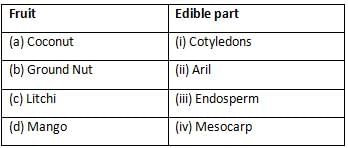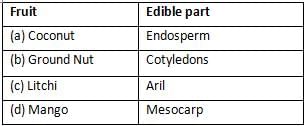Biology: CUET Mock Test - 5 - CUET MCQ
30 Questions MCQ Test - Biology: CUET Mock Test - 5
The suitable location for keeping the beehives is near the crop of:
Match the fruits with the appropriate edible part:

Select the correct answer using the code below:

In a dihybrid cross, what do the numbers 9, 3, 3, and 1 represent?
Which principle is illustrated by the dihybrid cross and its resulting ratio?
What is the Phenotypic ratio expected in the F2 generation of a dihybrid cross?
Which of the following statements are correct?
(A) Evolutionary mechanisms such as mutation and genetic recombination lead to genetic variation in populations.
(B) The theory of evolution by natural selection was fully accepted immediately after Darwin proposed it.
(C) The fossil record provides evidence of the gradual changes in life forms over time.
(D) The process of speciation results in the formation of new species from an existing population.
(E) Natural selection operates only on phenotypic traits, not genotypic traits.
Choose the correct answer from the options given below:
Which of the following statements are correct?
(A) Immunity can be acquired through vaccination.
(B) Passive immunity is always slow to respond.
(C) The body produces antibodies in response to an antigen.
(D) Malaria is transmitted by the Anopheles mosquito.
(E) HIV infection is spread only through casual contact.
Choose the correct answer from the options given below:
Which of the following statements are correct?
(A) Lactic acid bacteria (LAB) are used in the fermentation of milk to make curd.
(B) Yeast, Saccharomyces cerevisiae, is used in the production of ethanol and alcoholic beverages.
(C) Penicillin is produced by a bacterium, Penicillium notatum.
(D) Microbes are not used in the production of fermented food items like cheese.
(E) Biogas is primarily produced by methanogens from plant waste.
Choose the correct answer from the options given below:
What is the relationship between the two strands of DNA?
What is the role of complementary base pairing in DNA?
Which of the following statements are correct?
(A) Trichoderma is a fungus used as a biocontrol agent for controlling plant pathogens.
(B) Biogas is primarily produced through the action of methanogens on animal dung.
(C) Industrial fermentation uses large vessels called fermentors for microbial growth.
(D) Antibiotics are primarily produced by fungi to treat bacterial infections.
(E) Biofertilizers are chemical substances that are applied to improve soil fertility.
Choose the correct answer from the options given below:
Read the following statements carefully and select the correct statements.
(i) hPL plays a major role in parturition.
(ii) Fetus shows movements first time in the 7th month of pregnancy.
(iii) Signal for parturition comes from fully developed fetus and placenta.
(iv) Embryo's heart is formed by the 3rd month of pregnancy.
The milk produced during the initial few days of lactation, called colostrum, is essential for the new born as colostrums contains:
Which of the following statements is correct with reference to a test tube baby?
Read the given statement and select the correct option
Statement 1: Saheli is an pill which has high contraceptive value and very little side effects
Statement 2: It contains progestin with no estrogen, and a non-steroidal preparation called centchroman.
Which of the following organisms is used in the production of beverages?
A cloning vector has two antibiotic resistance genes- for tetracycline and ampicillin. A foreign DNA was inserted into the tetracycline gene. Non-recombinants would survive on the medium containing :
The colonies of recombinant bacteria appear white in contrast to blue colonies of non recombinant bacteria because of :
[NEET 2013]
DNA strands on a gel stained with ethidium bromide when viewed under UV radiation, appear as: [NEET 2021]
PCR and Restriction Fragment Length Polymorphism are the methods for :
[2012]
Which one of the following is not used as bio-fertiliser?
A doctor while operating on an HIV (+)ve patient accidentally cuts himself with a scalpel. Suspecting himself to have contracted the virus which test will he take to rule out/confirm his suspicion?
Introducing exotic species into new areas will:
i) increase competition for food & space.
ii) introduce diseases
iii) improve habitat
iv) lead to extinction of native species
Match List I with List II (NEET 2024)

Choose the correct answer from the options given below:





















